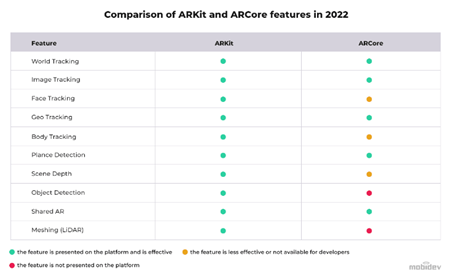Most people have already heard about AR headsets, but not everyone is constantly using these headsets as it is still not mainstream (Makarov, 2022). However, a device that almost every individual owns is the mobile phone. Business are trying to leverage this opportunity and this led to one of the biggest trend at the moment in the market of AR, known as mobile augmented reality. According to Craig, Mobile AR is a type of AR that you are able to take everywhere with you (Craig, 2013). It is mainly, small and lightweight devices that you are carrying with you anyway, for example smartphones and smart tablets.
A newly released creation in the field of Mobile AR, is the ARKit 6. The ARKit 6 is created by Apple and includes the possibility to make videos in 4K (Kuttichová, 2022). Furthermore, it includes features like Object Capture, which you can use to transform real-life objects into 3D models. For example, you can preview different paintings in your surroundings or even put on different kinds of shoes to see how they look on your feet. Also, a feature called the RoomPlan framework has been added. This feature allows people to scan the room and generate a 3D model, which includes all kinds of room-defining features, furniture and the option to full in the room’s parametric data. This feature gives people more freedom to reconstruct rooms.
If you compare Apple’s ARKit 6 with its’ competitor, Google’s ARCore, the ARKit 6 stand out as one of the best in the market (Craig, 2013). Moreover, the hardware of Apple’s mobile devices are more powerful and are able to handle the high-end ARKit 6 without problems.

Mobile AR has many advantages. We already carry most of the times the required hardware on us and are able to use it anywhere, anytime we want (Craig, 2013). Furthermore, it allows for ubiquitous learning. Mobile AR is also much cheaper compared to other AR technologies. Last but not least, one of the main advantages of Mobile AR is that most individuals already own the hardware (Smartphones). The only thing you probably have to do is download an application for the software.
On the other hand, there are also some disadvantages. There are constraints on the capabilities of smartphones and the usability of Mobile AR in a variety of different environmental conditions (Craig, 2013). Moreover, user understanding decreases if there is too much information on your screen. Especially when there is spam in the form of unwanted advertising/information in the augmented reality world. How would companies allow users to choose what they want to see and what to filter out?
I can see the use of Mobile AR, but personally I’m not sure if I would use the features regularly. For example, if I ever want to redecorate my room, using the RoomPlan feature can be useful but would I really use it? The feature does not seem that user friendly and easy to use. Until now I managed without the feature so I do not see the reason for using it. Moreover, if I am somewhere and I need information on something in my vicinity, I am not going to use mobile AR to get some information, rather I would just try to find the information on Google. I am used to this and it is a faster option than trying to film my surroundings and trying to read the text that appears on my smartphone, especially knowing that not all environments have met the conditions for the use of AR. Getting the latest mobile AR functions would not be a reason for me to buy a smartphone.
What is your opinion on Mobile AR, and specifically on it’s functions. Furthermore, would you use the functions regularly? Would buying the newest Iphone be worth it just for the latest mobile AR functions?
References
Craig, A. B. (2013). Understanding augmented reality : concepts and applications. Morgan Kaufmann. Retrieved September 21, 2022, https://web-s-ebscohost-com.eur.idm.oclc.org/ehost/ebookviewer/ebook/bmxlYmtfXzQ4NjAxMF9fQU41?sid=d4486cb8-1fc6-4dbc-8b98-e41aa508c89f@redis&vid=0&format=EB
Kuttichová, E. (2022, 5 juli). AR Trends: what to expect in 2022 – UX Planet. Medium. Retrieved 21 september 2022, from https://uxplanet.org/ar-trends-what-to-expect-in-2022-eed73f73c8ff
Makarov, A. (2022, 20 september). 12 Augmented Reality Trends of 2023: New Milestones in Immersive Technology. MobiDev. Retrieved 21 september 2022, from https://mobidev.biz/blog/augmented-reality-trends-future-ar-technologies

